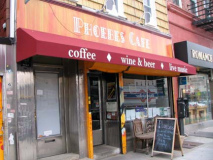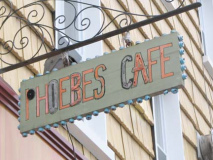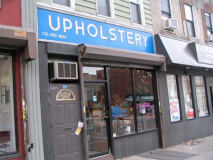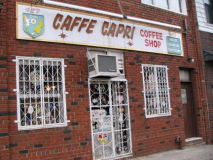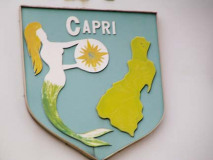After reaching Graham Avenue after duly noting the Gothic Most Holy Trinity/St. Mary’s Church and its satellite buildings after proceeding south on Manhattan Avenue, I turned north up Graham. The avenue runs from Flushing Avenue, where it meets Broadway and Marcus Garvey Boulevard (a.k.a. Sumner Avenue) north to Driggs Avenue and McGuiness Boulevard. Graham Avenue was named for 19th Century land speculators John and James Lorimer Graham (Lorimer Street is two avenues to the west).
WAYFARING: MANHATTAN and GRAHAM AVENUES
The avenue contains two distinct sections, as noted on street signs: Avenue of Puerto Rico, from Flushing Avenue north to Metropolitan Avenue, and Via Vespucci, from Metropolitan Avenue to the BQE, that reflect the primary demographic in each section.
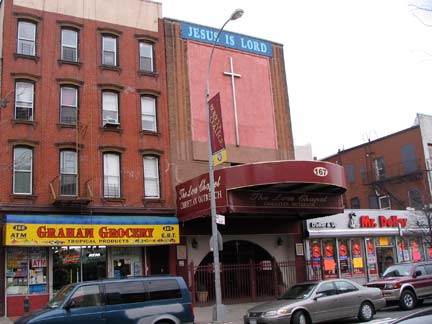

Former Rainbow Theatre, 167 Graham, constructed in an Art Moderne style, opening in 1937, closed 1967. After several years as a catering hall it is now a church (the Love Chapel, which sounds more like Las Vegas than Brooklyn). The 2-story space above the marquee used to have colored glass that reflected rainbow colors when light was shone through the back. RIGHT: The Rainbow in the 1930s. LaGuardia and Wagner Archives
ForgottenFan John Dereszewski: As a student at Most Holy Trinity from 1964 to 1968, I don’t remember the Rainbow functioning as a theater during that time. Also, I believe it became a church just after it closed as a theater. I certainly do not remember a catering hall being there at all.
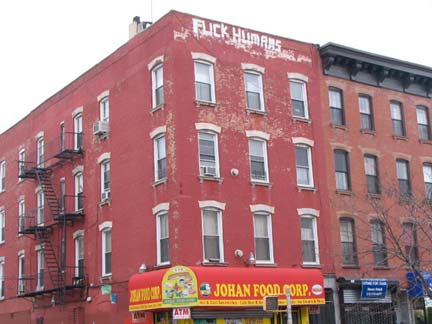

Catercorner, Graham at Meserole Street. Oddly, there is a Meserole Street in the East Willie, and a mile north, a Meserole Avenue in Greenpoint (the Meseroles were immigrants from France in the colonial era who settled in the general area). The inscription on the roof is telling; it likely had a cornice at one time, and now it has an imprecation.
Didn’t you get tired of Earth being constantly invaded and overwhelmed by aliens in 1950s B movies? Frankly, I’d like to give the pompous, overbearing Michael Rennie and the bucket of bolts Gort a boot in the rear end back to where they came from in The Day The Earth Stood Still. I prefer the Star Trek model, Kirk and Spock going to planet after planet throughout the galaxy and showing ’em how it’s done.
I’d like to know the story behind this grand Beaux Arts building.

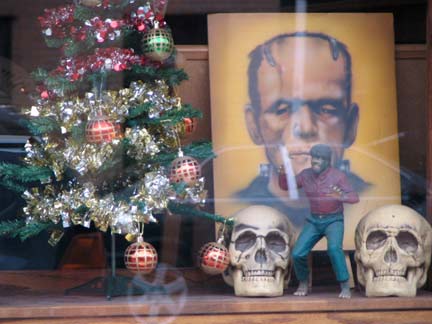
Judging from the awning sign you would think this place on Graham just north of Meserole would sell shoes, but it seems to have a little bit of everything available. I was here in early December, so the wolfmen, skulls and Frankensteins should have been given the hook weeks previous. But they were hanging in despite encroachment from Christmas trees.

IS 49, the William J. Gaynor Junior High School, is located amid the Williamsburg Houses facing Graham Avenue. Gaynor (1849-1913) was a NY Supreme Court Justice as well as NYC Mayor from 1910-1913. Gaynor is the only NYC mayor to have survived, albeit temporarily, an assassination attempt (1910, in Hoboken as he was on board the ocean liner SS Kaiser Wilhelm der Grosse awaiting departure — he died from the lingering effects of an unremoved bullet in his neck 3 years later).
Gaynor is buried in Green-Wood Cemetery.
Gaynor grew up on a farm near Utica, New York, and became a devoutly religious teenager, at one point contemplating a career as a teacher with the Catholic teaching order called the Christian Brothers. In 1873, at the age of 25, he left that notion behind, and decided to pursue law. He moved to Brooklyn, New York, and through his law practice became a great defender of the poor and a critic of government waste and misuse of power. Years of hard work and determination as the voice of the poor man were rewarded with a place on the New York Supreme Court, District 2, a bench he sat on from 1893 to 1907. His reputation as a man with a stubborn streak and propensity towards solitude led many in his ranks to dislike or misunderstand him, but there was also deep admiration for the man who stuck to his principles, never swaying for popularity or acclaim and never making his private life public domain. Though he wasn’t affiliated with any party formally, he was sought out by the Democrats for their mayoral nominee in the 1910 election. By the time he became mayor, he was in his early sixties, but his youthful exuberance and relentless energy made him more than a suitable fit for the demands of the job.
After being in office for less than a year, though, Gaynor was shot in the throat by James J. Gallagher, a disgruntled laborer recently fired from his job as a dock worker. Amazingly, Gaynor lived and continued to serve as mayor. A prolific letter writer, Gaynor wrote his sister about the entire attempt on his life, “My next consciousness was of a terrible roar in my head.” he wrote. “It filled my head, which seemed as though it would burst open. It swelled to the highest pitch, and then fell, and then rose again, and so alternated until it subsided into a continuous buzz. It was sickening, but my stomach did not give way. I was meanwhile entirely sightless.” Gallagher would be put away in an insane asylum. (Interestingly, Gaynor’s name did not appear on the indictment.) Holding on three years after the assassination attempt, Gaynor eventually died while still in office. His doctors would contend the bullet wound led to his death. He would go down in history as New York’s only assassinated mayor. Annabelle Magazine
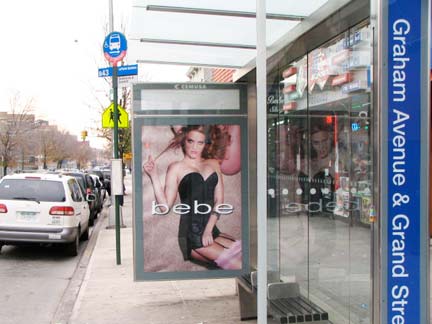
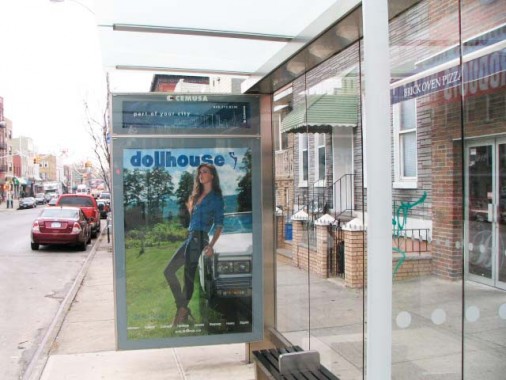
CEMUSA glass and metal bus shelters have been installed at spots along Graham Avenue, and advertisers have always known that an effective method of getting eyes on the ad is to prominently feature a cutie.

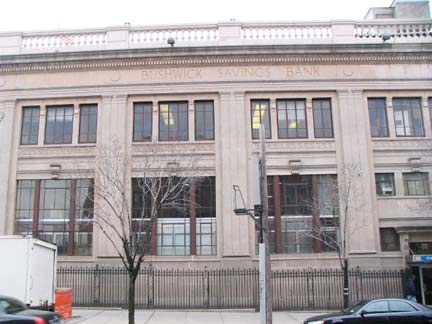
Bushwick Savings Bank, Graham Avenue at Grand Street. Established in 1868 (this building was likely built about 1910-1920) Bushwick merged with Anchor Savings Bank in 1969; this locale is currently home to a JP Morgan Chase branch.
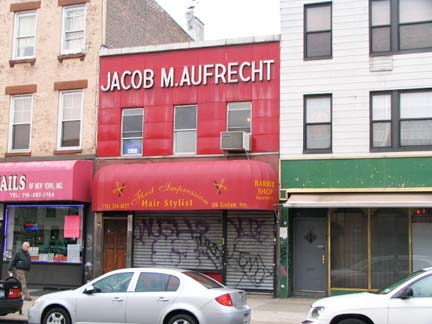
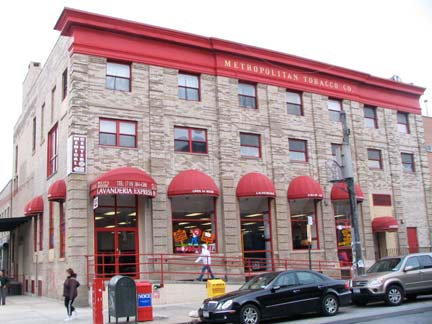
Long lost… Red is the trim color of choice along Graham north of Grand. Jacob M. Aufrecht was a realtor (his name appears in the wedding notices of the Brooklyn Daily Eagle, October 20, 1929).
This looks like a recently refinished building exterior, and the Metropolitan Tobacco Co. lettering at the top is new. However, there was indeed a tobacco company here, as listed in records of the invaluable Brooklyn Genealogy website.
“Slim” DONOVAN, a character in the old days, conducted the finest saloon in the old town of Williamsburg, at Powers Street and Graham Avenue. But the old frame structure that housed the saloon and home of Slim is no more. In its place stands the four-story brick building of the Metropolitan Tobacco Company. Daily Eagle
They built them well in the old days, as this handsome brick 4-story apartment building on the NE corner of Graham and Devoe attests. There are modern encroachments, such as cellphone transmitters.
I did not enter Phoebe’s Cafe but instead admired its collection of handpainted signage. Like many places, the reviews are mixed.
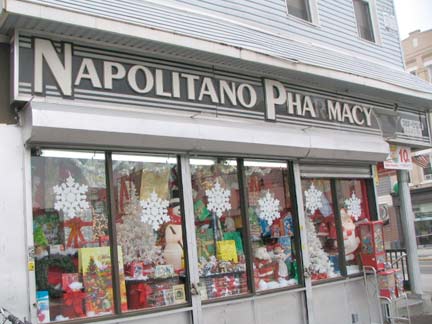
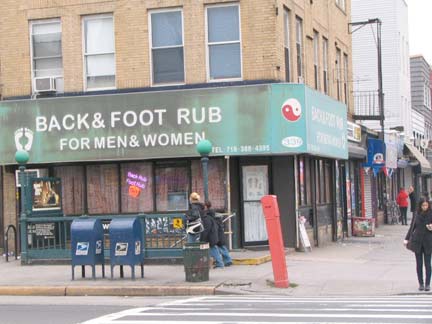
Metropolitan Avenue at Graham. The awning sign for Napolitano Pharmacy uses the underutilized Peignot (pronounced PEN-yo) typefont. RIGHT: The awning sign could just as well say, “Massage,” but chose to go with “back and foot rub.” Your webmaster has never had a massage, but there are many things I have not done.
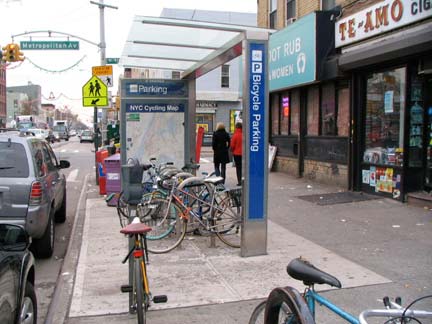
Just north of Met Ave on Graham: Bike parking shelters are a new concept in NYC, instituted by bike and pedestrian friendly Department of Transportation boss Janette Sadik-Khan. This one does not seem to lack patrons.

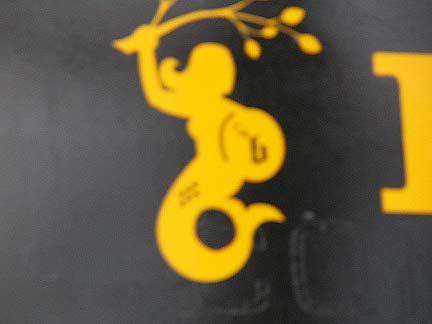
I was puzzled by the choice of a mermaid as a mascot for Brooklynski — mermaids, except those with incredible balance, would have a difficult time skiing, after all. Brooklynski, however, seems to be a play on the Polishness of Williamsburg and Greenpoint, and is instead an eclectic gift shop. [Turns out this is supposed to be a depiction of Syrena, the symbol of Warsaw]
I wish my Canon Powershot S1 IS had a feature that would indicate that it isn’t focusing and that no amount of fussing with it will make it focus.
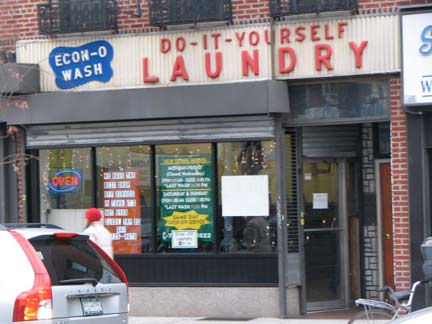
Between Met Ave and Conselyea: Vintage plastic-lettered Econo-Wash Laundry sign.
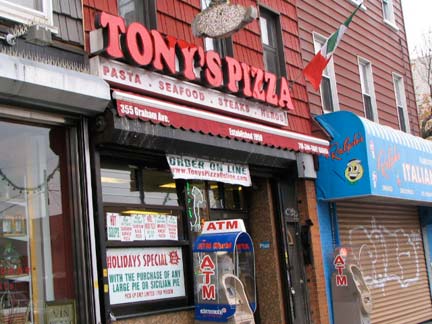
Tony’s Pizza is the preferred lunch spot for your webmaster in these parts, but the ovens are quite hot and the pizza needs to cool for about 5 minutes after you receive it.

Between Conselyea and Skillman Avenue: Daniel Castoria, the attorney, likely has nothing to do with Fletcher’s Castoria (now Fletcher’s Laxative), the children’s tummyache remedy, whose ads were painted by wall dogs on what appeared to be every empty wall from 1880-1910, apparently.
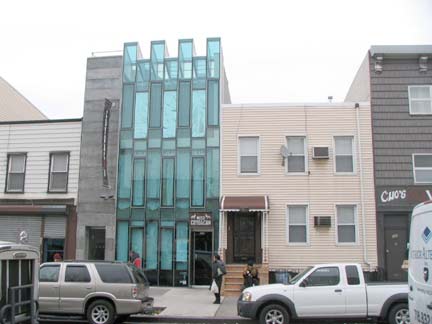
The glass-walled building trend has hit the East Willie, albeit modestly.
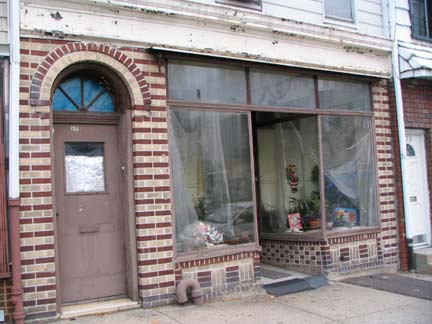
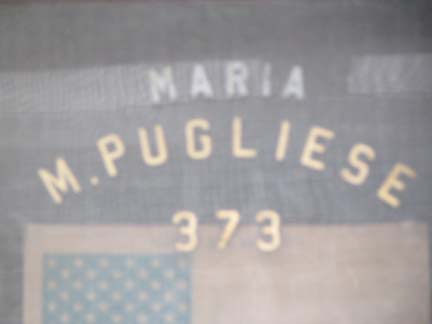
Yet another mysterious storefront at 373, with a nice contrasted-brick arched doorway; Maria M. Pugliese was your former proprietress.

Another vintage sign, for a memorial monument dealer. Usually these are congregated around cemeteries; the closest one is Calvary Cemetery across Newtown Creek.
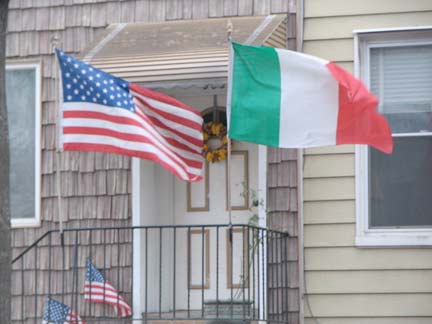
This should dispel any doubt we are now in the Little Italy section of East Williamsburg, where Graham Avenue is subtitled Via Vespucci, honoring explorer Amerigo Vespucci (1454-1512) a Firenze (Florence) native. In 1507 cartographer Martin Waldseemüller published an atlas in which the recently ‘discovered’ continent was given a modified version of Vespucci’s first name.
Two more classic signs — once you have something that works, why change? Capri is an island in the Tyrrhenian Sea, south of Naples, off the west coast of Italy. It takes its name from the Greek kapros, wild boar, which were likely found on the island by its earlier inhabitants. It has been a popular tourist destination for several decades; Rome’s caesars made it a popular rest and relaxation destination during the days of the Empire.
Mermaids, of course, would find it difficult to wear the pedal pusher pants made popular on the island.
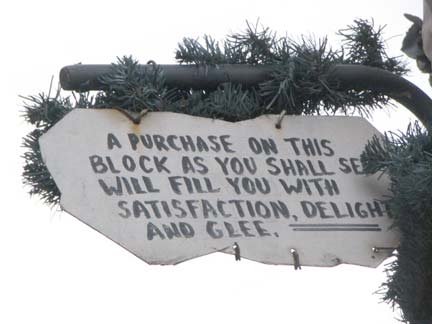
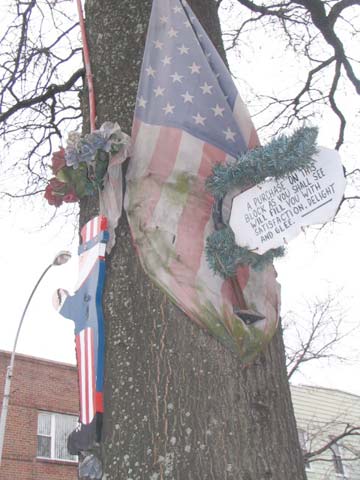
Graham Avenue at Frost Street. What’s the story behind this?
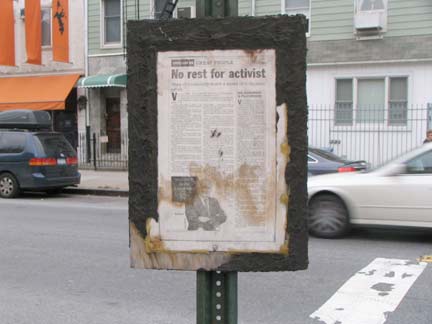
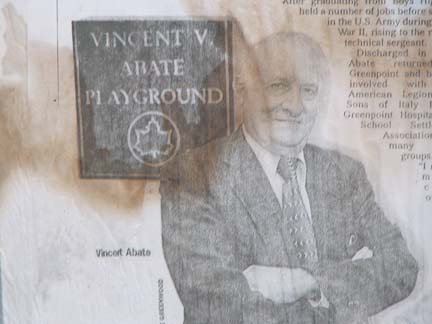
Here’s an article posted at Graham Avenue and Frost Street about a local activist, WWII veteran Vincent Vito Abate, who has a playground named for him in nearby McCarren Park. The article is several years old; your webmaster was also profiled in this Daily News series in 2000.
Since his days as an altar boy at St. Francis of Paola Church in Williamsburg, where he and his father built a grotto in 1938, Abate has been deeply involved in the Greenpoint and Williamsburg communities. A member of numerous community organizations, he has been the Chairman of Community Board 1 in Brooklyn, one of the boroughís most diverse neighborhoods, since 1980. Abate has belonged to the Greenpoint Hospital Advisory Board, the Greenpoint Hospital Planning Board, the New York City Cross Subsidy Fund, the American Legion, the Kings County American Legion, the St. Francis Bugle, Fife and Drum Cadet Corps, the Greenpoint-Williamsburg Comprehensive Health Board, and Don Bosco Knights of Columbus, among others. The Women, Infant and Children Nutrition Center at Greenpoint Hospital was named for him in 1981. NYC Parks
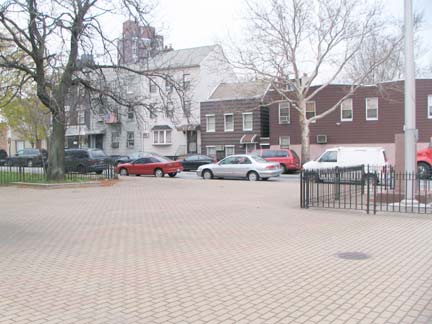
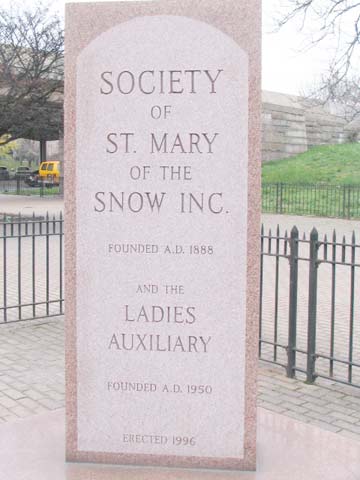
When the BQE was built in the region in the late 1930s a large plaza was created at Graham Avenue and Herbert and Richardson Streets. It’s identified alternately as “Our Lady of the Snows Square” on street signs and “St. Mary of the Snow” in the plaza. The name on the stand is the correct one; the religious organization is located at 410 Graham Avenue.
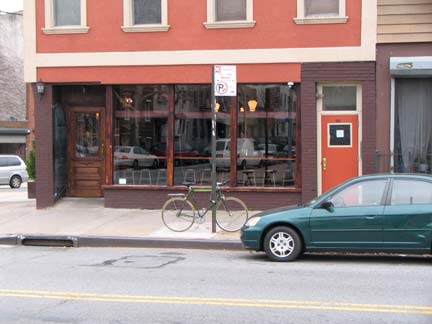
The present trend of not placing the name of a restaurant or bar on the exterior is carried through here at Graham and Richardson. The rationale seems to be that when your name is not on the outside, you can get only the patrons that you know or desire.
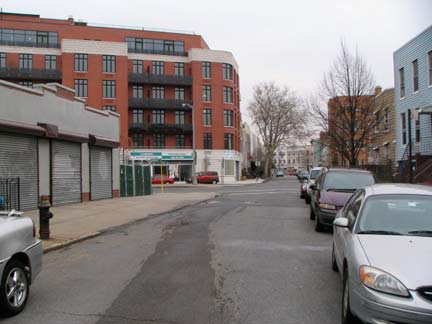
A glimpse of the new mega-condo, The Oakland, at Broome Street and McGuinness Boulevard. Here’s from the promotional brochure, via Miss Heather:
Our home is our joy at the end of the day, our deepest comfort, our refuge from the world. That world should be a place of inspiration and a source of comfort. That home should be made secure and safe. A place where craftsmanship is not a luxury. Where the same work and effort that you put lovingly put into making it a place of beauty is also same the standard expected from the developer.
We’ve passed through the dark ages of standard-less housing, welcome to the age of enlightenment. Welcome to The Oakland. A place where quality meets integrity. A place where satisfaction throughout your entire experience is our personal guarantee — from the sales team to the developer — starting today. We stand by our word and remain at your service.
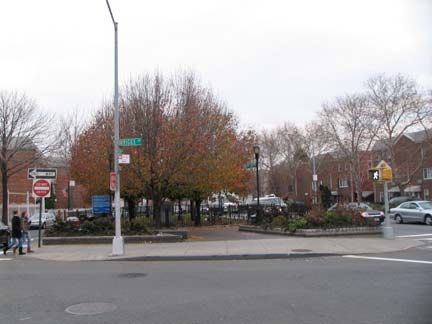
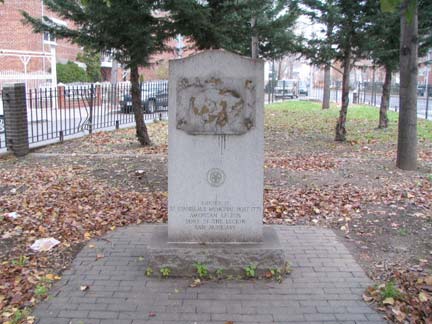
Graham Avenue ends its northward progress at Driggs Avenue and McGuiness Boulevard. Prior to 1964, Oakland Street’s southern end was at Driggs, but that year it was expanded into a multi-lane trafficway to bring traffic from the Pulaski Bridge south to the Brooklyn-Queens Expressway, and Oakland was renamed for Peter McGuinness, a long-time Greenpoint Democratic alderman and ward boss.
The triangular plaza here is named Father Studzinski Square. Fr. Studzinski (1887-1954) was the longtime pastor of nearby St. Stanislaus Kostka Church.
1/6/10



